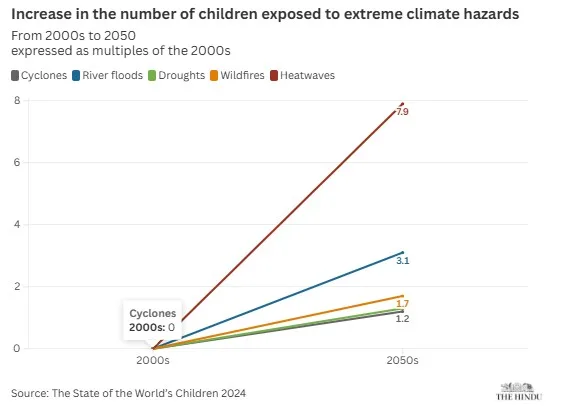Syllabus :GS1/Social Issues /GS 3/Environment
In News
UNICEF recently released The State of the World’s Children (SOWC) report .
About report
- It was first published in 1980, has significantly contributed to global child welfare
- Each SOWC report examines critical issues impacting children, such as disabilities, conflict, child labour, urbanization, and early childhood development.
- It provides a comprehensive analysis of global trends affecting children.
- The latest flagship report examines three major global forces impacting children’s lives — population shifts, the climate crisis and disruptive technologies .
Key findings
- Climate and Environmental Hazards: Nearly 1 billion children live in countries facing high climate and environmental risks.
- Children are particularly vulnerable to pollution, extreme weather, rising temperatures, and diseases (e.g., malaria, dengue, and Zika).
- Climate change impacts include contaminated water supplies, food insecurity, and mental health issues like trauma and anxiety.
- Projections for 2050s: Global newborn survival rates expected to rise to over 98%.
- The probability of surviving to age 5 increases to 99.5%.
- Life expectancy increases, with girls expected to live to 81 years and boys to 76 years.

- Impact of Extreme Weather: 400 million students have faced school closures due to extreme weather since 2022, disrupting learning and economic growth.
- Climate and environmental hazards are also leading to the displacement of children from their homes.
- Global Child Population Trends: By the 2050s, the global child population is projected to stabilize at around 2.3 billion.
- Significant increases in child populations in South Asia, Eastern and Southern Africa, and West and Central Africa, regions facing climate risks and limited digital infrastructure.
- Technological Advancements: Artificial intelligence, neurotechnology, renewable energy, and vaccine breakthroughs could improve childhoods.
- Digitalization can empower children but also exposes them to online risks, including sexual exploitation.
- Socio-Economic Conditions: 23% of the world’s children will live in low-income countries by the 2050s, more than double the proportion in the 2000s.
- GDP per capita is projected to more than double in East Asia, the Pacific, and South Asia by the 2050s.
- Urbanization: By the 2050s, nearly 60% of children will live in urban settings, up from 44% in the 2000s.
- Ensuring healthier and secure urban areas is crucial for future generations.
- Digital Divide: Over 95% of people in high-income countries have internet access, compared to only 26% in low-income countries.
- This digital exclusion exacerbates existing inequalities, especially in regions with rapidly growing child populations.
Recommendations
- UNICEF emphasizes that decisions made by world leaders today will shape the future children inherit.
- The report stresses that child rights must remain central to all strategies, policies, and actions to meet future challenges and ensure continued progress.
- There is a need to
- Increase investment in education, health, and sustainable urban development.
- Strengthen climate resilience in infrastructure and essential services.
- Ensure connectivity and the safe use of technology for all children.
Source:TH
Previous article
Facts In News 20-11-2024
Next article
India – CARICOM Summit